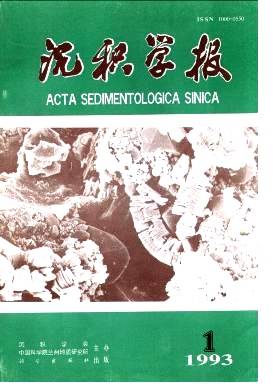Internal-tide Deposits in an Ordovician Submarine Channel, Fincastle, Appalachians, USA
- Received Date: 1991-12-04
- Publish Date: 1993-03-10
Abstract: Current- meter data collected over the past 20 years has revealed the existence of currents flowing alternatively up and down most submarine canyons and other submarine valleys. These currents are attributed to internal weaves that are subsurface waves between layers of different density or within layers where vertical density gradients are present. An important kind of internal wave is that which has a period equal to the semidiurnal or diurnal tide and referred to as an internal tied. Velocities of bidirectional deep-water currents range from 20-50 cm / sec. Such currents can move sediment up to fine sand and form a lot of ripples at depths of several thousand meters. Nevertheless, internal-tied deposits have not been recognized in the ancient rock record. Recently, the authors identified evidence for internal tides in an upped Middle Ordovician deep-water, submarine channel-fill deposit in Fincastle area, Virginia Appalachians, USA. During late Middle Ordovician time, the Fincastle area was located on the southeastern slope of a foreland basin. There was a series of submarine channels that were oriented southeast-northwest in the paleoslope. The channel-fill deposits are dominantly various kind of gravity flow deposits, showing an up- ward fining and thinning trend. The internal-tide deposits cap the up-fining sequence. Flute casts on the bottom turbidite beds and ripple cross laminations defining the C- division of Bouma sequences yield paleocurrent directions towards NW325-330. A calculated paleowater depth are more than 204m. Two internal-tide facies are recoginzed. 1. Bidirectionnal, cross-laminated, very fine-grained sandstone facies. This facies is composed mainly of very fine-grained, sublithic wackes and locally siltstones. Interbed-ded with this facies are dark shales and thin turbidite beds. This facies is characterized by well-developed, bidirectional ripple cross laminations that display high-frequency alternations of paleocurret azimuths, the paleocurrent directions are towards SSE and NNW and these directions are parallel to the submarine channel axes and correspond with up-and down-channel directions. A single bed of internal-tide deposit displays symmetrical or normal grading. The characteristics described above indicate that this facies cannot represent either turbidty-current or contour-current deposits. This facies is attributed instead to internal tides. Opposing paleocurrent modes may reflect either diurnal or semidiurnal tides. Grain-size variations with the layers of this facies record different maximum current velocities possibly related to Neap-Spring tidal cycles. 2. Unidireetiuual, Cross-bedded and eross-laminated medium- to fine-grained sandstone facies. This facies is composed of medium- to fine-grained lithic wacke and displays symmetrical grading. Two types of cross stratification were indentified. The first consists of tabular cross bedding and is developed in the middle of a bed. Its grain size is mainly medium-grained sandstone. The second stratification type consists of climbing ripple laminations and lies under or upon the tabular Cross bedding. It is developed in mainly fine-to very fine-grained sandstone. The foresets of two types of cross stratification trend towards the SSE. Obviously, this facies resulted from currents directed up the channel axes. Under conditions in which a high-energy- long-period internal wave is superimposed on an internal tied, a dominant up-channel and a subordinate down-channel current are produced. This facies is attributed to such a superimposed current.
| Citation: | Gao Zhenzhong, K.A.Eriksson. Internal-tide Deposits in an Ordovician Submarine Channel, Fincastle, Appalachians, USA[J]. Acta Sedimentologica Sinica, 1993, 11(1): 12-22. |






 DownLoad:
DownLoad: